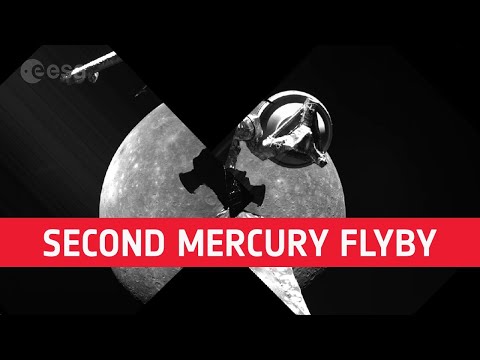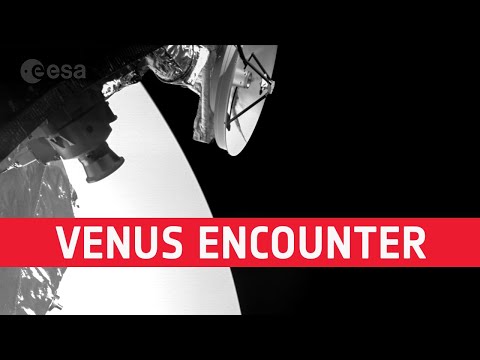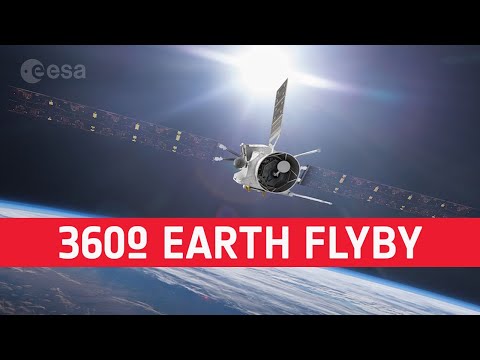BepiColombo’s first flyby
BepiColombo, ESA’s first mission to Mercury, is temporarily returning to Earth for its first planetary flyby on 10 April 2020.
Launched in October 2018, the spacecraft is on a seven year journey to the innermost planet in our Solar System. During this time, nine planetary flybys – one of Earth, two of Venus and six of Mercury – will reduce its speed and modify its trajectory.
The first flyby will see the Earth act as a brake to decelerate the spacecraft and fine tune its orbit towards the next scheduled flyby past Venus in October 2020. It will also give scientists the opportunity to calibrate the on board ultraviolet spectrometer, PHEBUS, and make measurements of the Earth’s environment using some of its instruments.
BepiColombo, a joint mission between ESA and the Japan Aerospace Exploration Agency JAXA, contains two scientific orbiters: the European Mercury Planetary Orbiter and the Japanese Mercury Magnetospheric Orbiter. It also contains a European transfer module and sunshade to cope with the high temperatures at the planet closest to our Sun. The spacecraft is scheduled to arrive in orbit around Mercury in December 2025.
Learn more about BepiColombo: http://bit.ly/ESABepiColombo
★ Subscribe: http://bit.ly/ESAsubscribe and click twice on the bell button to receive our notifications.
Check out our full video catalog: http://bit.ly/SpaceInVideos
Follow us on Twitter: http://bit.ly/ESAonTwitter
On Facebook: http://bit.ly/ESAonFacebook
On Instagram: http://bit.ly/ESAonInstagram
On Flickr: http://bit.ly/ESAonFlickr
We are Europe’s gateway to space. Our mission is to shape the development of Europe’s space capability and ensure that investment in space continues to deliver benefits to the citizens of Europe and the world. Check out http://www.esa.int/ESA to get up to speed on everything space related.
Copyright information about our videos is available here: http://www.esa.int/spaceinvideos/Terms_and_Conditions
#ESA
#BepiColombo
#Flyby





0:48 ummmm .. putting on the brakes doesn't reduce its speed , it actually speeds it up As it enters a lower orbit. cmon guys
Keep working ESA ! 👍😊
Que fantástica longa viagem…Mercúrio a meta mas com outras evidências espectacularés do Universo!! Gostei da infografia exposta com informação incrível!! A Bepi Colombo vai enviar fotografias relevantes das crateras que estão semeadas em Mercúrio?? Estas viagens são épicas no espaço e há surpresas???
Amazing technology ESA ☺️💙🚀🌍✨ . Good luck, let the mission succeed 🛰️ .
Great video !
Just popping down the road for some milk, via another country or two. See you in seven years.
7 years to get to Mercury seems like a really long time. I understand that orbital mechanics dictate such a long journey and I truly hope the spacecraft arrives at Mercury in relatively good health. Good job so far ESA.
So, this flyby is only needed because the probe couldn't launch with more fuel, right?
That makes it rather depressing.
Diversi anni fà , a seguito delle immagini riprese su cratere di Cerere , si rimando ad un'osservazione più dettagliata e definita del fenomeno mandando il satellite in un orbita ancora più ravvicinata . Ora sono passati molti anni e non si trova in rete ancora nessuna nova informazione e immagine su queste macchie bianche . Perchè , visto che dovrebbero essere disponibili? resta solo l'ipotesi oramai vecchia di anni che quelle macchie fossero materiale organico , ma niente di più . Potreste darmi qualche riferimento in merito per documentarmi ?? Siete in possesso e in gradi di publicare nel canale nuove immagini e analisi in merito ? grazie mille per la Vostra attenzione 🙂